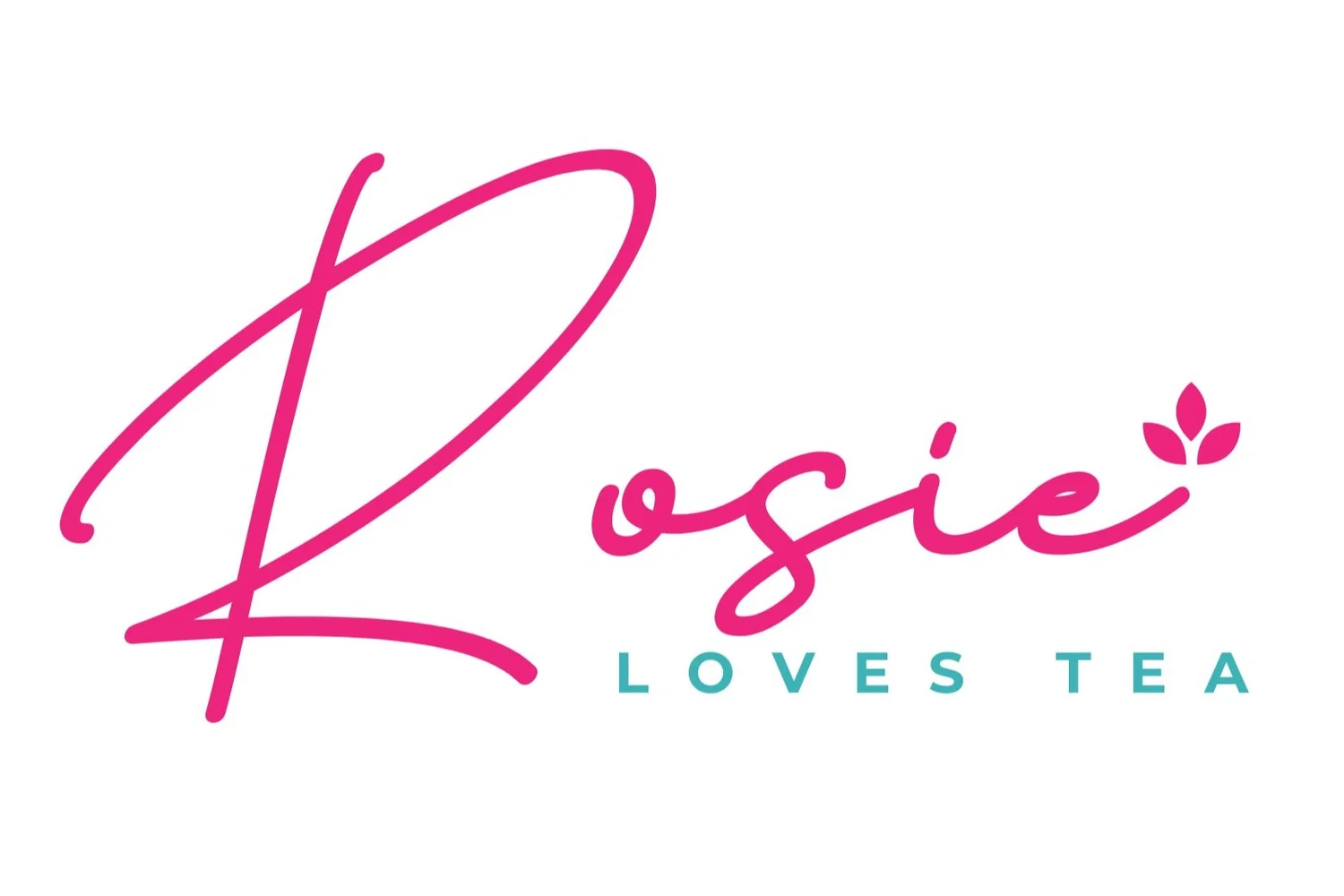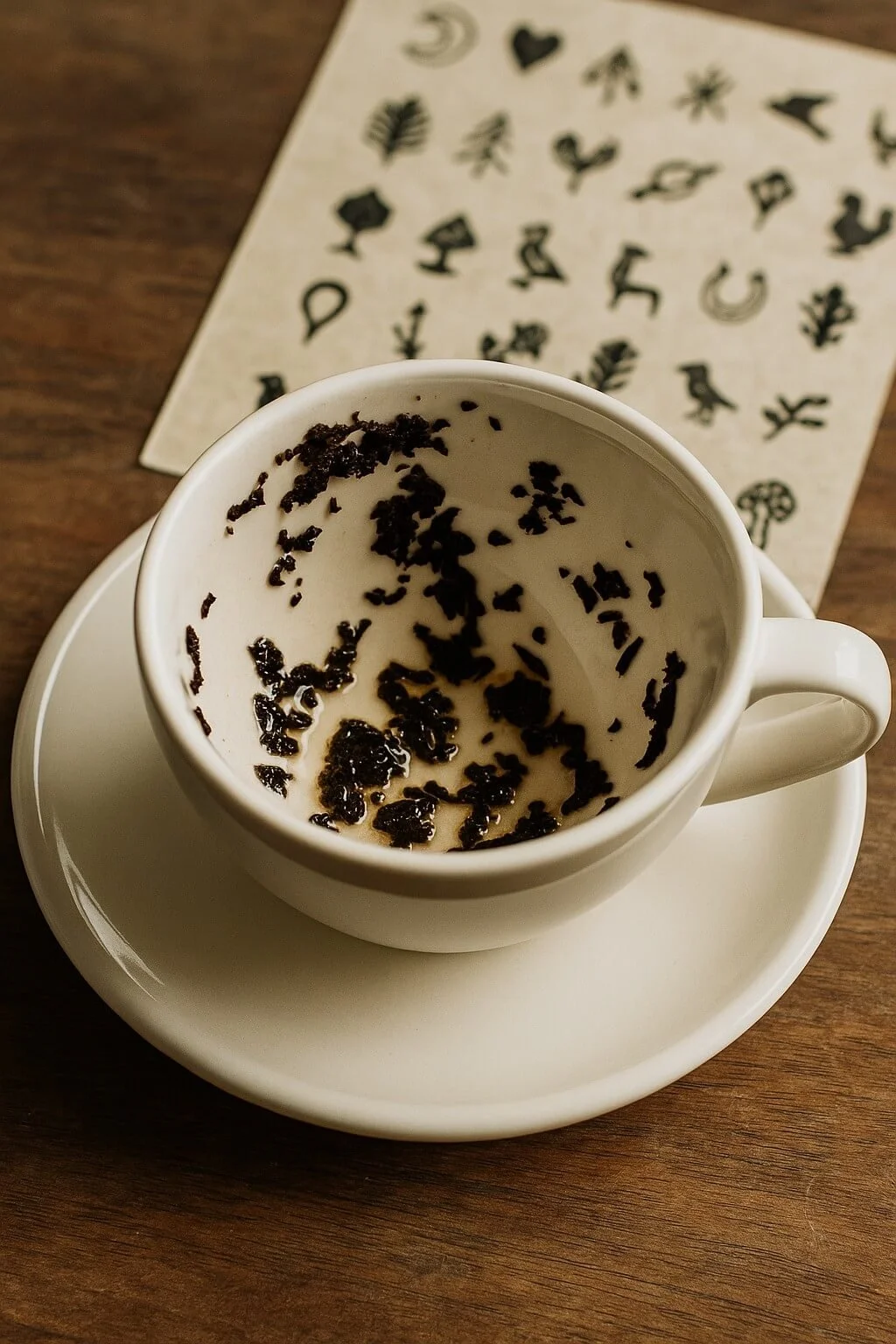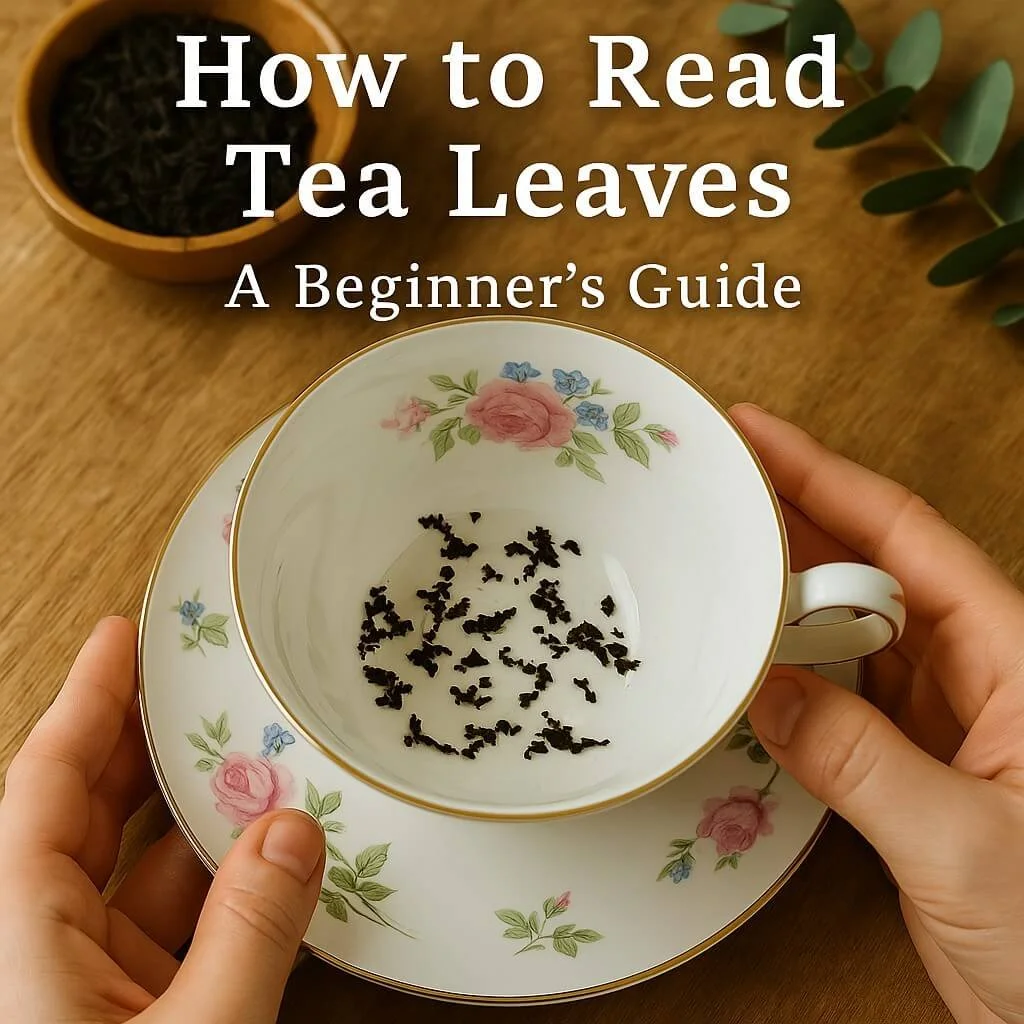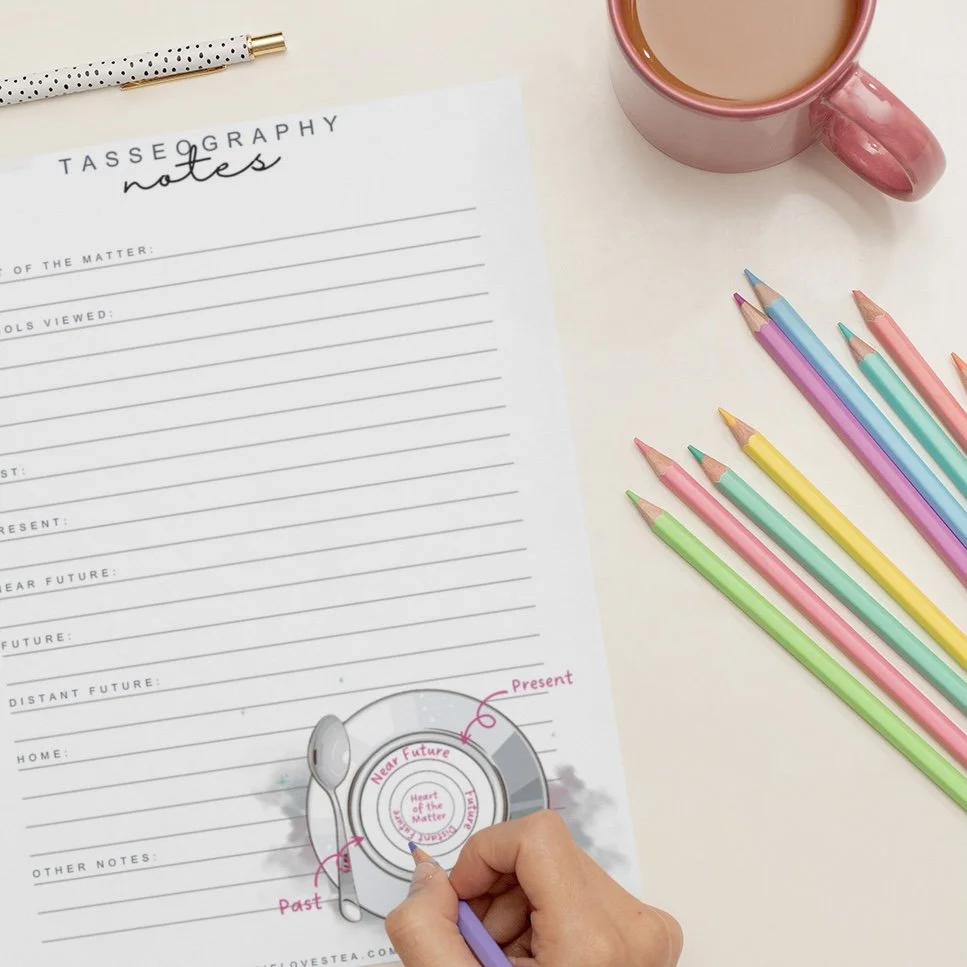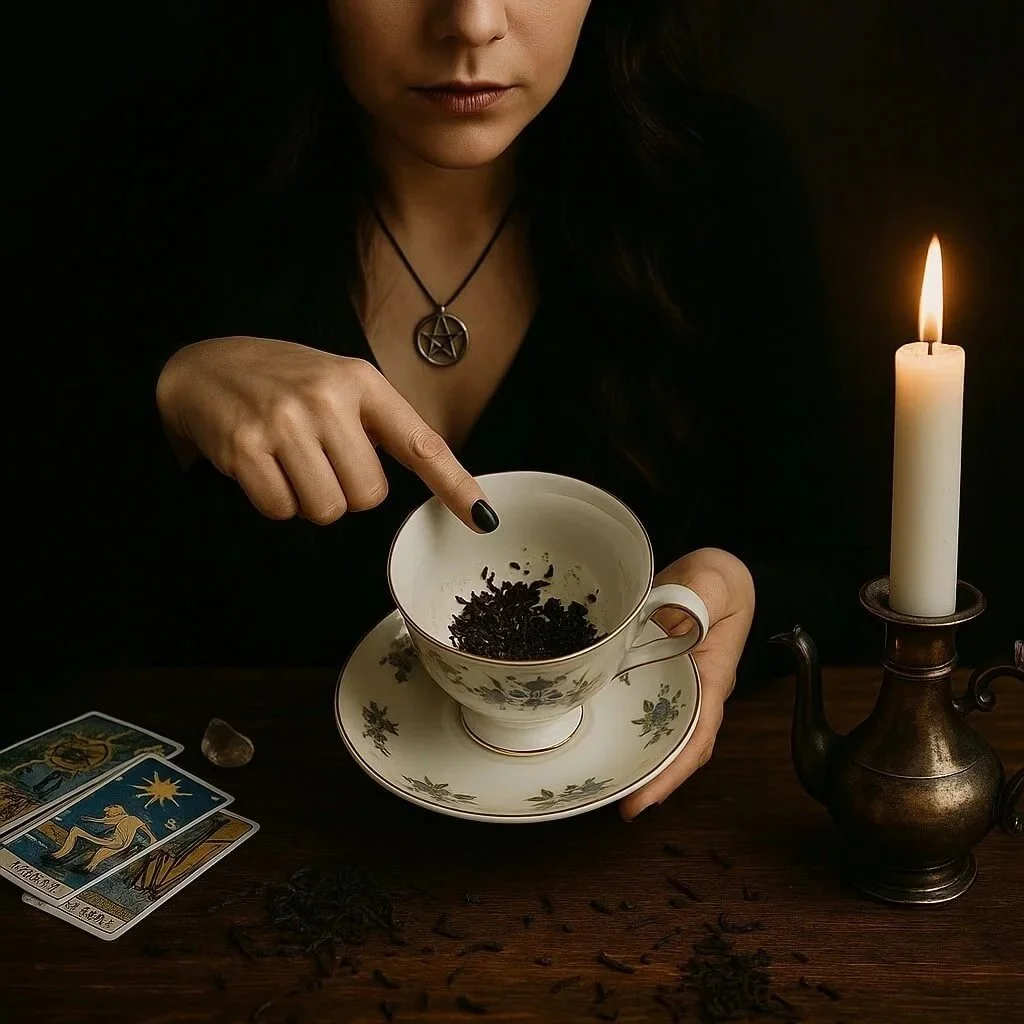Tea Leaf Reading: Your Morning Tea Might Be Hiding Secrets
Tea leaf reading, also known as tasseography, is an ancient art of divination that transforms the patterns left in your teacup into meaningful symbols and stories. For centuries, this mystical practice has been used to reveal insights about the past, present, and even the future, offering guidance, clarity, and sometimes a touch of mystery over a simple cup of tea.
Table of Contents
- Tasseography for Mindfulness
- Tasseography vs. Tasseomancy: What’s the Difference?
- How Does Tea Leaf Reading Work?
- What Does a Tea Leaf Reading Tell You?
- Do you need a Special Cup for Reading Tea Leaves?
- Step-by-Step Guide to Tea Leaf Reading
- Common Tea Leaf Reading Symbols and Their Meanings
- Frequently Asked Questions About Tasseography
In this beginner’s guide, you’ll uncover the history and cultural origins of tasseography, learn the step-by-step process for reading your own tea leaves, and explore the symbolism behind common shapes and patterns. You may be drawn to its spiritual significance, curious about its role in different cultures, or just want to try a fun ritual during your next tea break; this guide will help you on your tasseography journey.
Even if you’re a sceptic, something is enchanting about swirling the leaves, spotting images, and imagining the stories they might tell. Tea becomes more than a drink, it becomes a tool for reflection, creativity, and mindfulness.
It’s time to pop the kettle on, brew your favourite loose leaf blend, tilt the cup, and see what secrets your tea leaves might be ready to share with you!
You may also love to learn how to make the 👉 perfect cup of tea
Tasseography for Mindfulness
More people are turning to tea leaf reading each morning as a simple yet meaningful way to slow down and connect with themselves before the day begins. In a world full of constant beeping notifications and busy routines, this ancient practice offers a quiet moment of reflection and calm.
As the tea steeps and settles, so too does the mind, creating space for intuition, symbolism, and intention. Unlike other rigid meditation routines or overwhelming wellness trends, tea leaf reading blends ritual with creativity, allowing each person to interpret the shapes and patterns in a way that feels personal.
For many, it’s not about predicting the future, but about pausing long enough to listen inward, turning a regular cup of tea into a mindful morning ritual.
If you would like to try tasseography for mindfulness, download your free copy of this tea leaf reading journal. Simply download and fill in each day whilst you sip calmly on your morning brew.
Tasseography vs. Tasseomancy: What’s the Difference?
Both terms refer to the same art of reading tea leaves. “Tasseography” comes from the French “tasse” (cup) and Greek “graphia” (writing), while “tasseomancy” uses “mancy” to mean prophecy or divination. These terms are interchangeable, and both describe the spiritual, symbolic reading of tea leaves. Learn more about the history and cultural significance of tasseography.
If you love learning about the history of tasseography, you may also love to learn the 👉 history of tea
How Does Tea Leaf Reading Work?
Tea leaf reading, or tasseography, begins with a cup of loose-leaf tea. After drinking most of the tea, a little liquid is left in the bottom, then the cup is gently swirled and turned upside down on a saucer. Once the liquid drains, the leaves settle into shapes and patterns inside the cup.
The reader studies these patterns, spotting symbols such as animals, flowers, or letters, and noting their position in the cup. Each symbol carries a traditional meaning, but interpretation also depends on intuition and personal insight.
While not scientifically proven, tea leaf reading is a fun and fascinating way to reflect, spark imagination, and explore possible meanings hidden in your teacup!
What Does a Tea Leaf Reading Tell You?
A tea leaf reading (tasseography) can reveal different kinds of insight, depending on the symbols that appear and how they’re interpreted:
☕ Personal insights: Patterns in the cup may highlight aspects of your personality, emotions, or hidden desires.
☕ Future predictions: Many believe tea leaves can offer glimpses of what’s to come through symbolic shapes and omens.
☕ Spiritual guidance: Some readers view symbols as messages from ancestors, spirit guides, or higher powers.
☕ Relationship insights: Leaves may reflect feelings, conflicts, or connections influencing your relationships.
Ultimately, tasseography meanings are open to interpretation, shaped by the reader’s intuition and personal beliefs. Tea leaf reading remains a fascinating and imaginative way to explore your life, relationships, and possible future.
Do you need a Special Cup for Reading Tea Leaves?
While there are no strict rules about what type of cup should be used for tea leaf reading, many practitioners prefer to use a cup with a wide, shallow bowl and a plain, unpatterned interior. This is because a plain background can make it easier to see and interpret the shapes and patterns formed by the tea leaves.
Some readers also prefer to use a white or light-colored cup, as this can make it easier to see the darker tea leaves and their patterns.
There are also special cups designed specifically for tea leaf reading, called "tasseomancy cups" or "reading cups." These cups often have specific symbols or images printed on them that can help guide interpretations.
The most important factor is that the cup should be comfortable to hold and easy to swirl the tea leaves around in. As long as the cup has a wide, shallow bowl and a plain interior, it can be used for tea leaf reading.
🔮 Download Your FREE Tea Leaf Reading Printable Today
⬇️ Download your free tasseography journal today and start your tea leaf reading journey ⬇️
Step-by-Step Guide to Tea Leaf Reading
Here are some general step-by-step instructions for how to read your own tea leaves:
☕ Choose a tea: To begin, choose a loose-leaf tea that you enjoy and brew a cup of it. It's best to use a light-coloured or white cup with a plain interior for the most accurate readings.
☕ Drink the tea: Take your time and drink the tea slowly, focusing on your thoughts and intentions. It's important to drink the tea until there is only a small amount left in the cup.
☕ Swirl the leaves: Once you have finished drinking the tea, swirl the remaining leaves around the inside of the cup to distribute them evenly.
☕ Turn the cup: Turn the cup upside down onto a saucer or plate and allow the remaining liquid to drain out. Leave the cup upside down for a few moments to allow any excess liquid to drain out.
☕ Examine the leaves: Once the cup is empty, examine the leaves and any shapes or patterns that have formed. Look for any distinct shapes, such as animals, objects, or letters.
☕ Interpret the symbols: Interpret the symbols based on your intuition and any knowledge you have about tea leaf reading. There are many different interpretations of tea leaf symbols, so trust your instincts and go with what feels right to you.
☕ Take notes: If you are just starting out with tea leaf reading, it can be helpful to take notes of your readings to help you remember the symbols and their interpretations.
Allure's article on How to Read Tea Leaves offers valuable insights for those wanting to know more.
Common Tea Leaf Reading Symbols and Their Meanings
One of the joys of tea leaf reading (tasseography) is spotting shapes in your cup and uncovering what they might mean. While every reader’s interpretation is personal, there are many traditional tea leaf symbols that beginners can use as a guide.
Most symbols fall into five groups: animals, mythical creatures, objects, letters, and numbers. Each can offer a glimpse of insight, a hint of guidance, or simply a spark of imagination as you read your tea leaves.
🐾 Animals & Creatures
Aliens – exciting imagination and new ideas
Beetle or Insect – a battle or domestic confrontation
Birds – a journey or protection from your spirit guide
Dogs – faithful love and companionship
Elephants – strength, or carrying the weight of the world
Fox – cunning and sly, a warning about a devious friend
Owl – wisdom, caution against deceit
Pig – jealousy, gluttony, or hurt feelings
Rat, Rodent, or Mouse – escape, losses, or irritations
Reptiles – cold behaviour, feuds, or hostility
Snake or Serpent – caution, beware of betrayal
Spiders – determination, careful planning, weaving success
Unicorn – mythical lies or illusions, needing proof
✈️ Travel & Journeys
Aircraft – new experiences or something unexpected
Anchor – good luck, journey, or much-needed rest
Boots / Shoes – travel, hard work, strength; direction matters
Car / Carriage – wealth after a long journey
Castle – strength, security, protection
Mountain – overcoming challenges or involvement in others’ issues
🕯️ Symbols of Life & Spiritual Growth
Angel – blessings, love, or protection
Apples – health, success, or learning
Candle – enlightenment, peace, relaxation—or a passionate love affair
Coffin – endings leading to new beginnings
Eggs – fertility, new projects, or “sitting on news”
Feathers – spiritual growth and soul progress
Flowers / Bouquets – love, happiness, healing
Moon – success, reflection, or intuition
Tree – growth, love, deep roots, stable foundations
🎉 Celebrations & Messages
Arrows – news is coming, note direction
Baby – new beginnings or challenges
Balloons / Bubbles – celebrations or a warning of “bursting your bubble”
Bell – noisy demands, news, or visitors
Letter – communication is coming
Ring – marriage, commitment, cycles (see Circle)
⚖️ Challenges & Warnings
Circles – gifts, protection, completion of tasks
Clover – luck (four-leaf) or warning (three-leaf)
Feet – decisions ahead (see Boots)
Gun / Cannon – explosive arguments or strong emotions
Hammer – hard work, determination, repairing relationships
Heart – love, emotions, or a new romance
Hourglass / Clocks – time pressure or urgency
Iceberg – caution, emotions bigger than they appear
Keys – opportunities, new stages of life
Knife / Dagger – cutting ties, feuds, or betrayal
Ladder – growth, effort, and reward
Lines – depends on shape: straight (clarity) or wavy (uncertainty)
Scales – legal matters, or balancing home and work
Scissors – cutting ties or changes ahead
Star / Snowflake / Asterisk – love, beauty, optimism
Umbrella – protection, jealousy, or shelter from problems
🔠 Letters & Numbers
Letters – communication, important messages
Numbers – guidance varies by context, can represent dates, ages, or symbolic meaning
Frequently Asked Questions About Tasseography
What Tea is Best for Reading Tea Leaves?
When it comes to tea leaf reading, there is no one "best" tea to use. You can use any loose-leaf tea that you enjoy drinking, as long as it is not ground too finely. However, some teas are more commonly used in tea leaf reading due to their unique flavors and aromas, as well as their historical association with divination. Here are a few popular choices:
Black tea: Black tea is one of the most commonly used teas in tea leaf reading. It is strong and bold in flavor, which can help produce clearer and more distinct shapes and patterns in the leaves.
Green tea: Green tea is another popular choice for tea leaf reading. It has a lighter, more delicate flavor than black tea, which can result in more subtle and intricate shapes and patterns.
Herbal tea: Herbal teas, such as chamomile tea, lavender tea, or mint tea, are also commonly used in tea leaf reading. These teas have unique and distinct flavors and aromas that can produce interesting shapes and patterns in the leaves.
Ultimately, the most important factor is to choose a tea that you enjoy and that speaks to you personally. The more you connect with the tea, the more likely you are to have a successful and enjoyable tea leaf reading experience.
Who Invented Tea Leaf Reading?
It is not known who exactly invented tea leaf reading, as the practice has been around for centuries and likely evolved over time across different cultures. However, tasseography has been practiced in various forms in many regions, including China, India, the Middle East, and Europe.
Tea was first discovered in China more than 5,000 years ago, and the Chinese have a long tradition of using tea for both medicinal and spiritual purposes. As tea drinking spread along trade routes, it eventually reached Europe by the 17th century, where it became a widely consumed beverage. It is believed that tea leaf reading was introduced to Europe during this period, emerging as a form of entertainment at social gatherings.
During the Victorian era, tasseography became a popular parlor activity, especially among the upper and middle classes who were captivated by spiritualism, fortune-telling, and mystical practices. As tea drinking became more widespread due to the expansion of global trade, so too did the belief that the patterns left in tea leaves could reveal hidden truths about the future. This period also saw the publication of early tea leaf reading guides, which provided symbol interpretations and fueled the growing interest in divination and self-reflection. Explore more of this Victorian context of this practice.
In the Middle East, tea leaf reading is often referred to as "tasseomancy" and is believed to have originated in Turkey in the 1600s. It was practiced by both men and women as a way to gain insight into the future and make important decisions.
In India, tea leaf reading is known as "chaicup" and is often used as a spiritual tool to connect with one's inner self, offering guidance and self-reflection.
Overall, tea leaf reading has a long and rich history, and while its precise origins remain unknown, it has evolved and been practiced across many cultures and traditions throughout the centuries.
What is the Cup of Destiny?
The Cup of Destiny’, also known as the Fortune-Telling Tea Cup, is an essential tool for both tea leaf reading and coffee reading. Designed in the elegant Edwardian style, this cup makes it easier to interpret symbols and patterns by guiding the reader through their placement and meanings within the cup. By using this specialized cup, you can uncover insights into your past, present, and future through the art of tasseography.
This beautifully crafted divination set includes a tea cup, saucer, and an accompanying explanation book, making it a perfect choice for both beginners and experienced readers looking to enhance their fortune-telling practice.
For a deeper look into tea leaf reading symbols and their interpretations, check out The Project Gutenberg EBook of Tea-Cup Reading, and the Art of Fortune-Telling by Tea Leaves, by 'A Highland Seer'a classic guide to deciphering the hidden messages in your tea cup.
What is Coffee Reading?
Coffee reading, also known as tasseography or coffee cup reading, is a form of divination that uses the patterns formed by coffee grounds in a cup to interpret symbols and gain insights into the future. Like tea leaf reading, coffee reading has a long history, and is believed to have originated in the Middle East in the 16th century, where it was practiced by Sufi mystics.
The process of coffee reading is similar to tea leaf reading. A cup of coffee is prepared using freshly ground beans, and then consumed or poured into a cup. The cup is then swirled to move the grounds around, and then inverted onto a saucer to remove the liquid. The remaining coffee grounds are left to dry for a few minutes, during which time they will settle into shapes and patterns that can be interpreted by the reader.
The interpretations of the patterns and symbols in coffee reading are often influenced by cultural and regional differences. For example, in Turkey, coffee readings are often focused on relationships and family matters, while in Greece, they may be more focused on career and financial matters. In some cultures, coffee readings are also considered a form of hospitality and are often performed for guests after a meal.
One key difference between coffee reading and tea leaf reading is the size and shape of the symbols and patterns. Coffee grounds are typically larger and darker than tea leaves, which can make it easier to see larger symbols and shapes in the cup. Additionally, the thickness of the coffee grounds can affect the interpretations of the symbols and patterns, as thicker grounds may indicate different things than finer grounds.
Overall, both tea leaf reading and coffee reading are fascinating practices with long histories and cultural significance. While they have some similarities in their methods and interpretations, they also have unique differences that make each practice distinct.
Read more: Making Tea Around the World
Tea Leaf Reading in Practice: What’s Next?
Tea leaf reading is a fascinating practice that can provide insight and guidance into your life and future. Whether you are a seasoned practitioner or just starting out, there are many ways to deepen your understanding of tasseography and make it your own.
To get started, focus on choosing the right tea, understanding cup preparation, and practicing symbol interpretation. The more you explore, the more intuitive the process will become. Keep a tea leaf reading journal to record your findings and track recurring symbols over time.
Want to take your tea leaf reading skills to the next level? Download my free eBook, "The Beginner’s Guide to Reading Tea Leaves," which includes step-by-step instructions, a symbol interpretation chart, and expert tips to help you master the art of tasseography.
👉 Click here to download your FREE eBook and start reading the leaves today!
I have the most wonderful childhood memories of looking into the leaves with my sister, mum and grandma. We would often visit my grandma, drink tea, eat cake and share stories and chat about what we see in our cups. As a little girl, I was mesmerised by the magic and intrigue of the pictures created within my cup and loved using my imagination to work out what it could all mean.
Tea leaf reading is a fabulous way to get friends and family together for an afternoon of fun and fortune telling, whether you are a believer or not. If drinking tea isn't for you, there is always the option of using coffee grounds or even wine sediments. Many people around the world use these methods in place of tea leaves. Wine reading sounds like a fun girls night in activity. Or perhaps tipsy tea cocktails could be used!
Read More Articles About Tea
It is important to note that any health advice provided in this article is for informational purposes only and should not be taken as medical advice. Always consult with a qualified healthcare professional before making any changes to your diet, exercise routine, or overall health. The information provided is not a substitute for professional medical advice.
